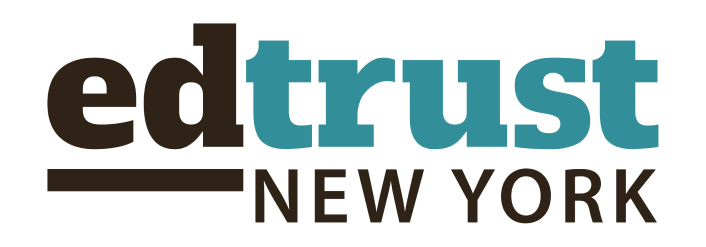New York State leaders created Foundation Aid in 2007 — the primary source of state funding for public schools — to support high-need school districts.
Although it was fully funded only in the 2023-24 school year, outdated data and the impact of the pandemic have contributed to significant challenges faced by districts.
New York State’s 2025 Enacted State Budget called for the Rockefeller Institute to conduct a study to assess Foundation Aid and discuss potential modifications to the formula. Public hearings and opportunities for testimony are being held across the state, with a focus on engaging community stakeholders — like EdTrust-New York and our partners — in this process.
At EdTrust-New York, we believe the current formula does not accurately reflect the needs of today’s students and any improvements must be student- and equity-centered. In summary, that means updating the funding formula to better reflect current student needs — including revising outdated base cost models, updating the Regional Cost Index, and adopting more measures that accurately reflect the needs of students experiencing poverty, students experiencing homelessness or foster care, multilingual learners, and students with disabilities. We also call on state leaders to improve data transparency to ensure that funds are equitably distributed and reach students who need the most support.
Arlen Benjamin-Gomez, executive director of EdTrust-New York, read and submitted the below testimony or the Rockefeller Institute Foundation Aid Study on July 16th, 2024 in New York City, which goes further in-depth into changes EdTrust-New York believes should be addressed in this study. Watch the full testimony here.
—-——————————————————————————————————————
The Foundation Aid formula has a profound impact on students, including students of color and those from low-income backgrounds. While the needs of these students have been growing for years, districts have been hamstrung due to years of state underfunding of the Foundation Aid formula; which was not fully funded until this school year — 17 years after it was first passed by the State. A 2018 Alliance for Quality Education report showed that the state underfunded 25 high-needs, majority Black and Latinx districts by $2.6 billion, contributing to the challenges faced by districts prior to the pandemic.
These challenges were only exacerbated by the pandemic. Multiple studies have shown that students of color and students from low-income backgrounds disproportionately experienced unfinished learning. This is illustrated by 2022-23 New York State Assessment scores showing that only 42% of NYCPS students from low-income backgrounds were proficient in third grade reading and eighth grade math. While we are grateful the Foundation Aid formula is now fully funded, more is needed to address the challenges created by years of underfunding and the pandemic.
EdTrust-New York agrees that the Foundation Aid formula needs to be updated and improved. However, any changes must be equity-focused. Current student outcomes make clear that any funding cuts to New York City Public Schools would likely only exacerbate equity gaps across the city.
Additionally, New York City Public Schools has been making important new investments in evidence-based reading and math instruction and any reduction in state aid could jeopardize their impact. At the same time, New York City Public Schools is now required to implement a new class size law but is receiving no additional state funding to do so. Any changes to the funding formula should take all of these increased costs into account.
Before sharing our recommendations, I want to note that EdTrust-New York is concerned about the aggressive timeline for this study and urges a comprehensive and data-driven process that puts the needs of students above any state fiscal or political considerations. We are concerned the timeline and summer stakeholder engagement does not allow for sufficient engagement. We hope this study will represent the first step in a longer-term, comprehensive process that includes the Legislature, Governor, and additional experts and stakeholders across the state before any legislative action is taken.
Our Recommendations:
Base Cost: New York currently determines the base formula cost using a Successful School District model. This model has not been updated by the New York Stated Education Department since 2012, does not reflect changes in state standards and assessments since that time, and is not generally representative of large urban and small rural districts. As a result, the model does not accurately reflect the base cost of successfully educating students.
- The study should explore alternative methodologies in consultation with school finance experts, and explore more effective models, such as the New Jersey Professional Judgement Panel methodology.
Regarding the Regional Cost Index: it reflects analysis of regional labor market costs but that data has not been updated since 2006 and is not reflective of the current market costs in high-priced areas such as NYC.
- The study should explore updates to the Regional Cost Index to better reflect the costs of salaries and services, which have greatly increased.
Poverty: The current formula uses a combination of the number of students eligible for free and reduced-price lunch (FRL) and the number of school-aged children in families below the poverty threshold using U.S. Census data. Unfortunately, the FRL measure is often inaccurate and is less reliable since the adoption of federal Community Eligibility provisions. Additionally, NYSED continues to use 2000 Census poverty data, even though annual updates are available.
The study should explore:
- Alternative student poverty measurements that move away from FRL such as enrollment in means-tested programs like Medicaid, which has been successfully implemented in Maryland and is being piloted in Tennessee.
- Use both a per pupil socioeconomic status weight and a concentrated poverty weight, like California’s Local Control Funding Formula (LCFF) which more than doubles the weight for high-need students in districts with a concentration of student need above 55%.
- Use tiers of socioeconomic status with differentiated weights, rather than a single yes/no poverty weight. For example, Jefferson County (KY) Public Schools uses a tiered approach to socioeconomic status which then determines school enrollment and funding.
Multi-Lingual Learners: Since the formula was created in 2007, the Foundation Aid formula provides a single weight for these students. Students at different levels of English proficiency require different and more intensive language instruction and supports. Additionally, there are three language instructional models in New York State, each with different costs associated with implementation.
- The study should explore differentiated weights by proficiency level and type of services and programs. The study should also explore the costs associated with educating subgroups of multilingual learners, such as students with interrupted formal education (SIFE).
Students with Disabilities have a diverse set of needs yet the current formula provides a single weight for these students, with additional funding available for services at higher costs. A single weight does not properly account for different costs associated with students’ individualized education plans.
- The study should explore and analyze differentiated weights in funding for students with disabilities based on student needs and instructional settings.
Students in Temporary Housing and Foster Care: NYC has consistently had a large population of these students, yet the state does not provide additional funding for these students who require additional resources to meet their unique needs.
- We recommend an additional weight for both groups as part of an updated formula.
Finally, there is a need for improved data transparency.
Since districts have significant flexibility in how Foundation Aid funds are allocated to and used by schools, there must be strong public transparency to ensure funds are equitably spent. For example, based on EdTrust-New York’s school funding tool, we know that while New York City spends more per student in elementary/middle schools with the greatest need, that is not true across all groups of students. For multilingual learners, schools with the lowest shares of multilingual learners spend almost the same amount per student as schools with the highest share of multilingual learners. This suggests that weighted funding for multilingual learners is not reaching students, but greater data transparency is needed to know how schools spend funds.
We recommend improving and reinstating the New York State School Funding Transparency Forms which districts were required to submit to the state by Education Law 3614 from 2018-2023 and were made available publicly. Furthermore, NYSED should publish the district-level annual State Aid Projects on Foundation Aid in an accessible and comparable manner.
To learn more about the Foundation Aid study from the Rockefeller Institute and how to submit a written testimony, click here.

